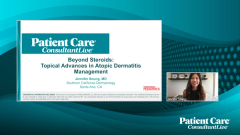
An Overview of Topical Therapies for Atopic Dermatitis
An expert discusses the shift from reactive to proactive treatment of atopic dermatitis (AD), emphasizing personalized care and the growing role of advanced nonsteroidal topicals—such as PDE4 and JAK inhibitors—alongside updated guidelines aimed at improving clinician awareness and patient outcomes.
Episodes in this series

This segment explores evolving treatment strategies for AD, highlighting the transition from reactive to proactive care. Historically, management centered around short bursts of oral steroids during flares. Now newer systemic treatments allow for continuous control, reducing flare frequency and improving patient quality of life. A polling question revealed that most clinicians prioritize treatment effectiveness (88%) when choosing therapies, followed by concerns over adverse effects (46%), cost (46%), and finally patient preference. The speaker notes the importance of considering AD’s heterogeneity—its presentation varies by age, severity, and skin tone—necessitating personalized care.
The discussion then shifts to updated American Academy of Dermatology guidelines emphasizing the expanding landscape of topical treatments. Topical corticosteroids remain foundational due to their fast-acting efficacy, particularly during flares, though they are intended for short-term use. Calcineurin inhibitors such as tacrolimus and pimecrolimus offer strong alternatives, especially for sensitive areas such as the face or groin. Newer nonsteroidal options have gained traction: PDE4 inhibitors such as roflumilast offer improved efficacy without the stinging often seen with earlier formulations, thanks to more elegant, barrier-repairing vehicles. JAK inhibitors deliver fast itch relief by targeting specific inflammatory pathways. Lastly, aryl hydrocarbon receptor agonists present a novel mechanism that allows effective long-term use without steroid-associated risks.
Polling also revealed that the vast majority (83%) of providers still start with topical steroids for mild-to-moderate AD, underscoring the importance of educating clinicians about these newer, nonsteroidal options. When first-line treatments fail, responses vary: 35% try a different steroid or calcineurin inhibitor formulation; 26% opt for PDE4 inhibitors; and smaller percentages escalate to systemics (13%) or refer to dermatologists (22%). JAK inhibitors and tapinarof were least selected, reflecting either unfamiliarity or limited access. This underscores the educational goal of the session: increasing awareness and confidence in using advanced topical therapies for AD management.
Newsletter
Access practical, evidence-based guidance to support better care for our youngest patients. Join our email list for the latest clinical updates.

